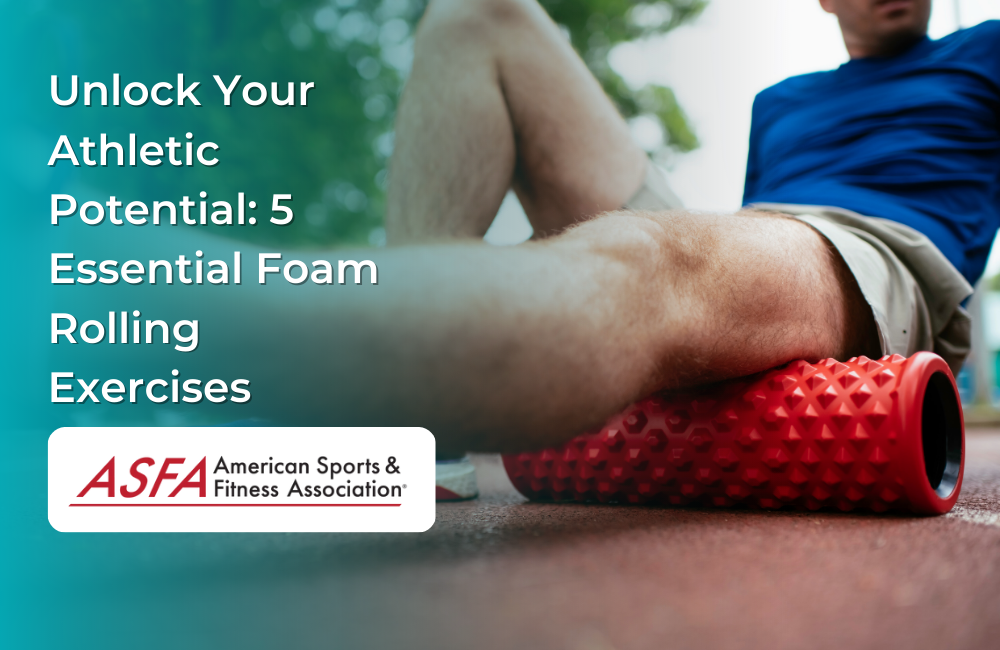As an athlete, you're constantly pushing your body to its limits to achieve peak performance. To keep your body in top shape, recovery is just as important as training. Foam rolling, a self-myofascial release technique, is a powerful tool that aids recovery, enhances mobility, and helps prevent injuries. In this blog, we'll explore five essential foam rolling exercises that every athlete should incorporate into their routine to maintain flexibility, alleviate soreness, and unlock their full athletic potential.
The iliotibial (IT) band is a thick, fibrous tissue that runs from the hip to the knee, stabilizing the knee joint during movement. It's common for athletes to experience IT band tightness, which can lead to discomfort or injury. Foam rolling the IT band helps alleviate tension and promote flexibility.
- Lie on your side with the foam roller positioned under your hip.
- Cross the top leg over the bottom leg, placing the foot flat on the floor.
- Using your arms and the top foot, gently roll back and forth from the hip to the knee, pausing on any tight spots for 20-30 seconds.
Your quadriceps, or the muscles at the front of your thighs, play a critical role in running, jumping, and other athletic movements. Targeting these muscles with a foam roller can help alleviate soreness and improve overall flexibility.
- Lie face down with the foam roller positioned under one of your thighs.
- Prop yourself up on your forearms, keeping the opposite leg bent with the foot resting on the floor.
- Slowly roll from the top of your thigh down to the top of your knee, focusing on any tight spots and spending 20-30 seconds on each.
- Hamstring Foam Roll
The hamstrings, located at the back of your thighs, are crucial for explosive movements and overall stability. Tight hamstrings can hinder performance and increase the risk of injury, making foam rolling an essential practice for athletes.
- Sit on the floor with the foam roller positioned under your hamstrings, just above the knee.
- Support your upper body with your hands, placing them behind you.
- Lift your hips off the ground and slowly roll up and down the length of your hamstrings, pausing on any tight spots for 20-30 seconds.
- Calf Foam Roll
Calf muscles are prone to tightness and soreness, especially in athletes who engage in high-impact sports. Foam rolling the calves can help reduce muscle tension and promote flexibility.
- Sit on the floor with the foam roller positioned under one calf, just above the ankle.
- Support your upper body with your hands, placing them behind you.
- Cross the opposite leg over the leg you are rolling, applying additional pressure if desired.
- Gently roll up and down the calf, targeting tight spots and holding for 20-30 seconds each.
- Upper Back Foam Roll
The upper back, specifically the thoracic spine, can become stiff due to postural stress or intense workouts. Foam rolling this area helps improve posture, mobility, and overall spinal health.
- Sit on the floor with the foam roller positioned behind you, just below the shoulder blades.
- Support your head with your hands, interlocking your fingers behind your neck.
- Bend your knees with your feet flat on the floor.
- Lift your hips off the ground and gently roll up and down the upper back, avoiding the lower back and neck.
- Pause on tight spots for 20-30 seconds before moving on.
Incorporating these five foam rolling exercises into your regular routine can significantly improve your athletic performance, reduce the risk of injury, and aid in recovery. By dedicating just a few minutes each day to foam rolling, you'll be taking a proactive approach to your health and unlocking your full athletic potential.





